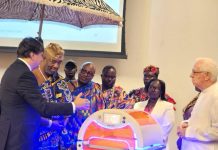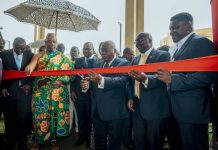The African Continental Free Trade Area is widely accepted as a game-changer for economic growth, industrialization and sustainable development in Africa.
Despite the opportunities, challenges need to be addressed. Fears of significant tariff revenue losses and an uneven distribution of costs and benefits are among the main obstacles to the continent’s integration.
There are justifiable reasons for the formation of common currency among countries but one of the goals in the context of trade is to coordinate the economic activity of goods and services, and monetary policy across member states; lowering transaction costs of cross-border trade. This phenomenon is called the Currency Union which is often referred to as a “monetary union.”
Per analyses, the African Continental Free Trade Area (AfCFTA) is a full-fledged version of a currency union. Thus AfCTA goes beyond just the sharing of a common currency to further integration including the adoption of a single market in order to facilitate cross-border trade, which entails the elimination of physical and fiscal barriers between countries to free the movement of capital, labor, goods, and services in order to strengthen overall economies.

So many years ago , even before the birth of AfCTA, African countries have failed several times to launch a single currency like the Euro. But in 1991, the Abuja Treaty, an international agreement signed in Nigeria, created the African Economic Community (AEC) and called for an African Central Bank to follow by 2028. As of 2019, the plan is to establish an African Economic Community with a single currency by 2023.
The African Economic Community (AEC) is an organization of African Union states establishing grounds for mutual economic development among the majority of African states. The stated goals of the organization include the creation of free trade areas, customs unions, a single market , a central bank and common currency.
It took so many years of series of common currency debates but when EU finally decided to do this, it took 3.5 years for the EU to create their common currency (Euro) with 19 member states out of 27. Why is it taking AU so many decades to create theirs, since 1991?
There are two existing regional currency unions in Africa, using the West African CFA Franc and the Central African CFA Franc. The African Union’s plans for further integration encourage the development of more such regional unions as an intermediate step to full monetary union.
One proposed union is the ECO, a proposed currency for members of the Economic Community of West African States (ECOWAS). We have moved beyond the puzzle of whether a common currency is key for African single market or not. Hence, there’s no doubt a common currency will unleash trade liberation and drive competitive economic dynamism for the African Economic Community.
African Leaders must note that there can never be a single market if trading is still going to take place with varied currencies under the AfCTA. Money is indeed the medium of exchange of goods and services; the currency of trade.
I am 100% convinced that if these two proposed variables are well-considered, the ultimate purpose of the AfCTA will be fully realized;
1. One Money Market
Ghana like any other African country has many cities/towns with different markets. Some of these cities/towns serve as a marketplace for both wholesale and retail of certain goods whiles others serve as only retail marketplace. But imagine each of these cities have their own currencies to trade with; fiscal barriers will be created resulting in price hikes and inter-town market inflations.
The Ghana Cedis is the only currency of trade used in any of these market. This actually makes inter-town trading appears to be happening in a single market. Liken Africa to Ghana, and you will understand exactly what the AfCTA is seeking to do in terms of creating a single market.
With the African perspective, we can’t tell each of the African countries to use the currency for a common one. Just like the Euro currency, most European countries do have their own local currency but engage with a common currency within the eurozone.
The European Economic and Monetary Union (EMU) or EU, is comprised of 27 member nations, 19 of whom have adopted the euro as their official currency. The EU introduced the euro in 1999, and physical euro coins and paper notes were introduced in 2002 but note that the euro is the national currency of the EU member states who have adopted it, including Austria, Belgium, Finland, France, Germany, Greece, Ireland, Italy, Luxembourg, the Netherlands, Portugal, Spain, Cyprus, Estonia, Latvia, Lithuania, Malta, Slovakia, and Slovenia.
These countries form the Eurozone, a region where the euro serves as the common national currency. Additionally, four other non-EU nations (Andorra, Vatican City, San Marino, and Monaco) use the euro as their official currency and several countries have their currencies pegged to the euro.
Likewise, AU can introduce a common currency and allow member states to decide whether to adopt it as their national currency or peg their currency to it. For example, the Hong Kong dollar has been pegged to the U.S. dollar since 1983.
A currency peg is a policy in which a national government sets a specific fixed exchange rate for its currency with a foreign currency or basket of currencies. The U.S. dollar, the euro, and gold have historically been popular choices. Currency pegs create stability between trading partners and can remain in place for decades. For example, the Hong Kong dollar has been pegged to the U.S. dollar since 1983.
2. Industrialization
There’s absolutely no point for AfCTA , if the single market is going to be a hub for retail consumption of goods and services produced by other continents. Each of the member states of AfCTA must be known for specific production or manufacturing.
For example , Ghana must be adopted as a marketplace for the processing of all cocoa products while tomato paste production for Togo, Crude Oil refinery for Nigeria. That said, selected goods that can easily be produced in Africa by an AfCTA member state must be encouraged instead of importing such products into the single market.
Our single market must be known for exports more than imports. Industrialization is usually associated with increases in total income and living standards in a society. An improved Unemployment rate is assured.
3. Free Movement
Trade without easy movement of people, capital, goods, and services is an economic exercise in futility. The freedom of movement of people, capital, goods, and services are the aspired four basic freedoms which make up the African continental and regional integration agendas.
There is a need to reconstruct the Freedom of Movement Protocol to ensure that member states of AfCTA can benefit fully from the liberalized market that is being created by the AfCFTA
An essential part of the European Single Market is the guarantee of the four fundamental freedoms: the free movement of goods, persons, services, and capital.
EU citizens may enter and stay in the territory of another Member States for up to three months without being subject to any conditions or formalities other than the requirement to hold a valid identity card or passport. EU citizens have the right of residence for longer than three months if they meet certain conditions.
AfCTA must not become a library of information but rather a tool for economic transformation; allowing every letter of the AfCTA document to become a reality within the corridors of the single market.












































